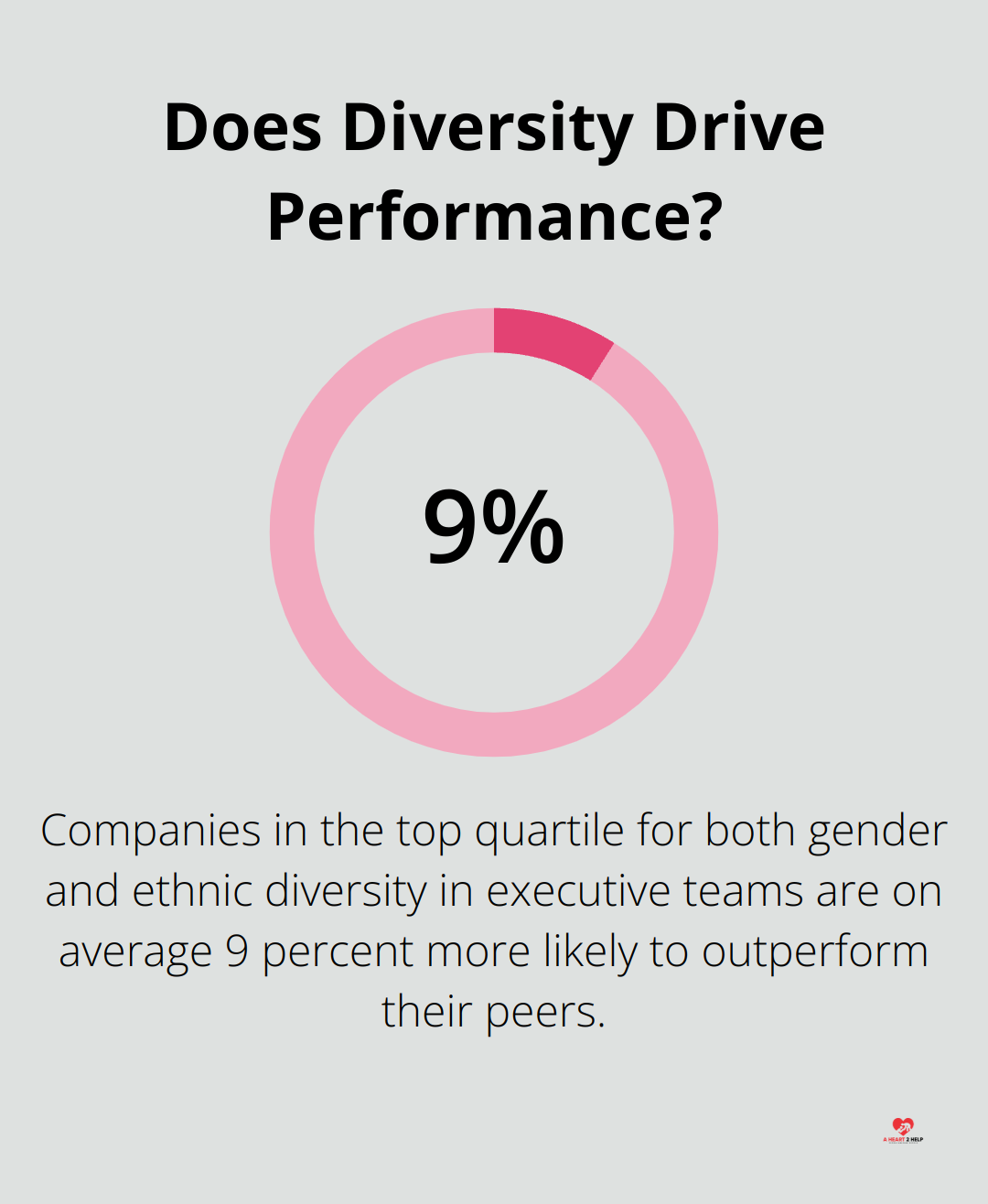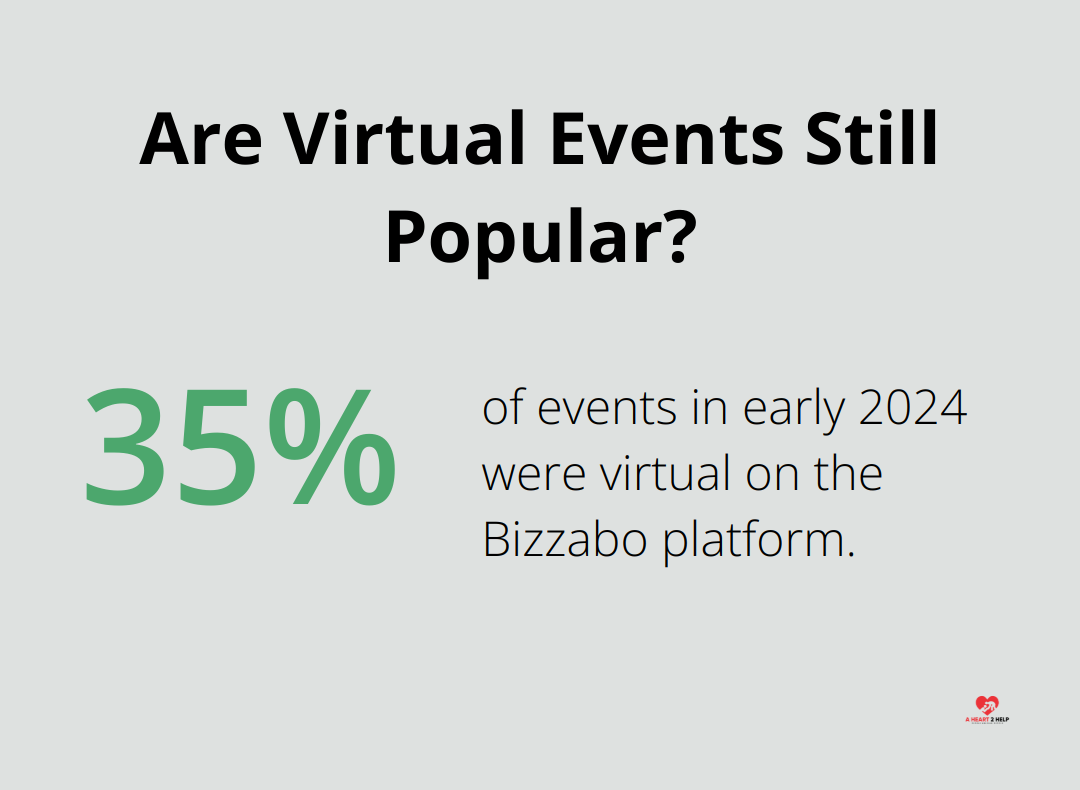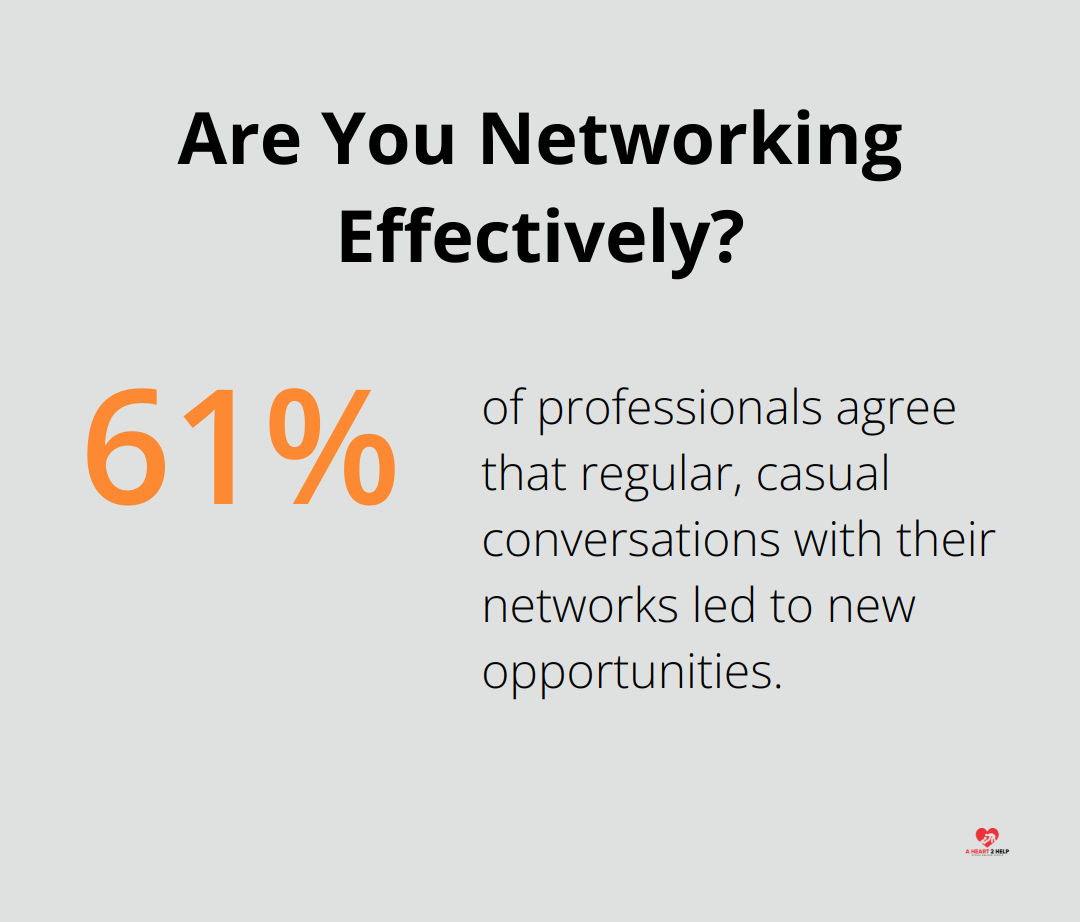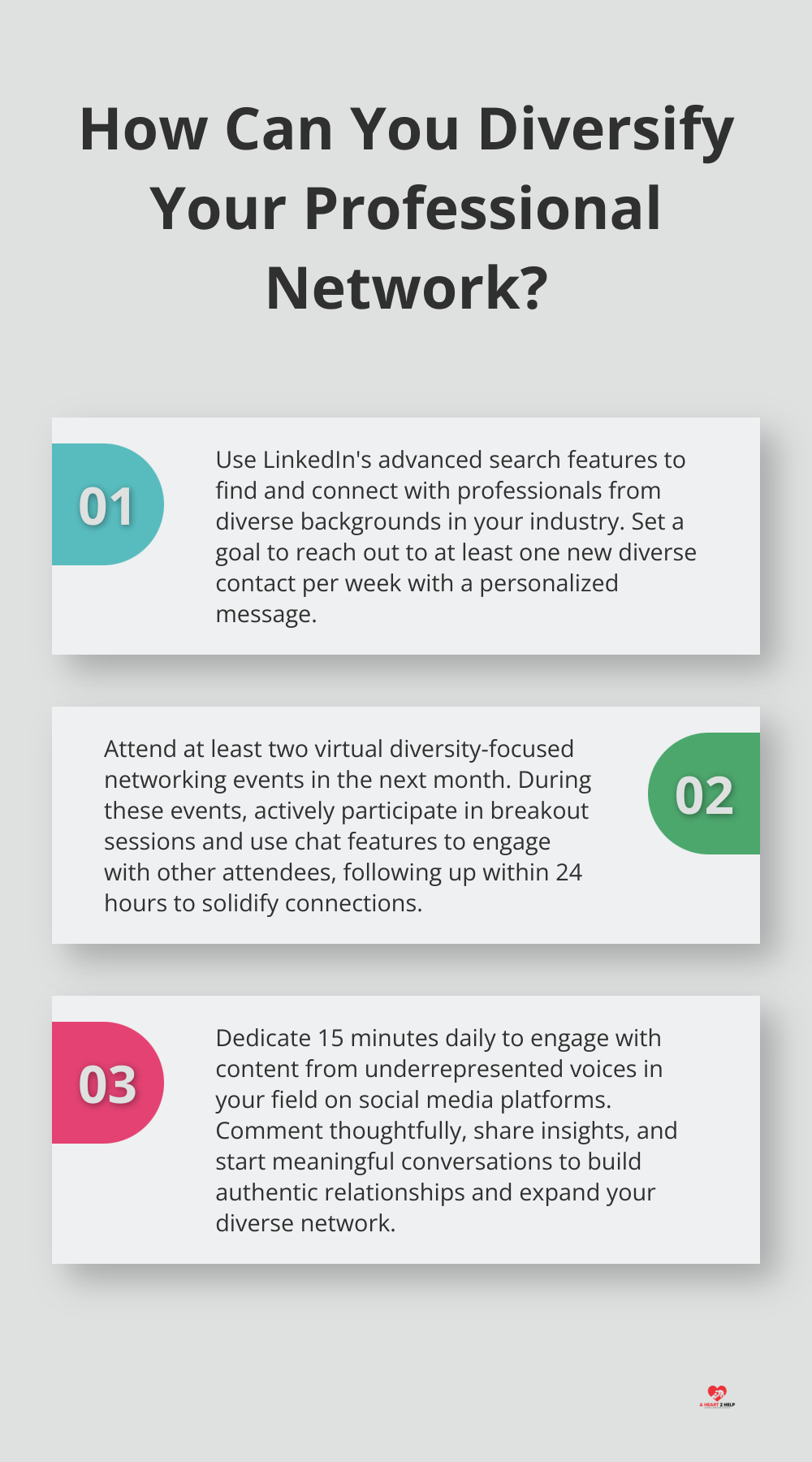In today’s interconnected world, diversity networking has become a powerful tool for professional growth and innovation. At A Heart 2 Help, we’ve seen firsthand how embracing diverse perspectives can transform organizations and careers.
The digital age has opened up new avenues for connecting with professionals from all walks of life, breaking down geographical and cultural barriers. This blog post explores why diversity networking matters now more than ever and how you can harness its potential in the digital realm.
How Diversity Boosts Professional Networks
Diversity in professional networks transforms the way we work and innovate. A study by McKinsey reveals that companies in the top quartile for both gender and ethnic diversity in executive teams are on average 9 percent more likely to outperform their peers. This statistic underscores the tangible impact of bringing different perspectives to the table.
Sparking Innovation Through Diverse Thinking
Connections with professionals from various backgrounds expose you to new ways of thinking. This exposure often results in innovative solutions that a homogeneous group might overlook. For instance, a team at Google (with members from different cultural backgrounds) developed a more inclusive image recognition algorithm, which improved the product for users worldwide.
Expanding Your Global Reach
Diverse networks unlock doors to global opportunities. They provide insights into different markets and help you understand diverse customer bases. A report by Deloitte indicates that organizations need to thrive in a boundaryless world. This adaptability proves essential in our rapidly changing digital landscape.
Accessing a Wider Talent Pool
A diverse network naturally leads to a more diverse talent pool when you hire or look for collaborators. By tapping into diverse networks, you don’t just fill positions; you bring in fresh perspectives that can drive your organization forward.
Enhancing Cultural Intelligence
Interacting with a diverse network enhances your cultural intelligence (CQ). This skill proves invaluable in today’s global business environment. A study published in the Academy of Management Learning & Education journal found that individuals with high CQ are more likely to succeed in cross-cultural business situations.
Fostering Creativity and Problem-Solving
Diverse networks foster creativity and improve problem-solving capabilities. Research published in the Proceedings of the National Academy of Sciences (PNAS) shows that diverse groups outperform homogeneous ones in decision-making tasks. This advantage stems from the variety of perspectives and approaches that diverse teams bring to challenges.

As we move forward, it’s clear that building a diverse professional network requires effort, but the rewards are substantial. The next section will explore how to leverage digital platforms to create and nurture these valuable diverse connections.
How to Build Inclusive Digital Networks
In the digital age, building inclusive professional networks has become more accessible than ever. Social media platforms offer unprecedented opportunities to connect with diverse professionals worldwide. LinkedIn, for example, boasts over 900 million members from more than 200 countries and territories (a vast user base that provides a rich tapestry of perspectives and experiences).
Maximize Social Media for Diverse Connections
To leverage social media effectively, optimize your profile to reflect your commitment to diversity and inclusion. Use inclusive language in your bio and highlight any relevant experiences or skills related to working with diverse teams. Actively seek out and follow thought leaders from underrepresented groups in your industry. Engage meaningfully with their content by commenting, sharing, and starting conversations.
Join Online Diversity-Focused Groups
Professional networking platforms host numerous groups dedicated to promoting diversity in various industries. For instance, the “Diversity in Tech” group on LinkedIn has over 50,000 members sharing insights and opportunities. Join such groups to connect with like-minded professionals, stay informed about diversity initiatives, and participate in discussions that broaden your perspective.
Embrace Virtual Networking Events
The shift to virtual events has made attending diversity-focused conferences and networking sessions more accessible. Recent research shows that 35% of events in early 2024 were virtual on the Bizzabo platform. This trend opens up a world of opportunities to connect with diverse professionals globally without the constraints of travel.

When you attend virtual events, actively participate in breakout sessions and use chat features to engage with other attendees. Follow up with new connections promptly after the event to solidify relationships. Many platforms (like Hopin and Remo) offer virtual networking features that simulate in-person interactions, making it easier to forge meaningful connections.
Cultivate Authentic Relationships
As you build your inclusive digital network, authenticity and genuine interest in others’ experiences are key. Approach each interaction with curiosity and openness. You’ll find that your network not only grows in size but also in depth and value.
The next section will explore effective strategies to make the most of your diverse digital network, ensuring that these connections translate into meaningful professional relationships and opportunities.
How to Network Effectively Across Cultures
Master Active Listening
Active listening forms the foundation of effective cross-cultural networking. Research shows that those who engage in active listening are seen as more competent, likable, and trustworthy by others. To improve your active listening skills:
- Focus entirely on the speaker, avoid distractions.
- Ask clarifying questions to understand their point of view.
- Paraphrase what you’ve heard to confirm your understanding.
- Pay attention to non-verbal cues, even in virtual settings.

Cultural differences can affect communication styles. Some cultures value direct communication, while others prefer indirect approaches. Adjust your listening style accordingly.
Build Authentic Relationships
Authenticity strengthens diverse networks. A LinkedIn survey reveals that 61% of professionals agree that regular, casual conversations with their networks led to new opportunities. To foster authentic relationships:
- Share your experiences and challenges openly.
- Show genuine interest in others’ backgrounds and perspectives.
- Follow up consistently after initial meetings or conversations.
- Offer help or resources without expecting immediate returns.
Advocate for Underrepresented Groups
Take an active role in advocating for underrepresented groups. Companies with more diverse workforces perform better financially (McKinsey). Your advocacy not only supports others but also contributes to better business outcomes.
Try these practical ways to advocate:
- Recommend diverse candidates for job openings or speaking opportunities.
- Share content created by underrepresented professionals in your field.
- Mentor individuals from diverse backgrounds.
- Speak up against discriminatory practices or comments in professional settings.
Enhance Cultural Intelligence
Cultural intelligence (CQ) proves essential for effective diversity networking. Individuals with high CQ are more likely to succeed in cross-cultural business situations (Journal of World Business). To enhance your cultural intelligence:
- Read about different cultures and their business practices.
- Attend cultural awareness workshops or webinars.
- Seek out diverse mentors who can provide insights into their cultural experiences.
- Practice empathy and avoid making assumptions based on stereotypes.
These strategies will equip you to build a robust, diverse professional network that can drive innovation and success in your career. Effective diversity networking requires continuous learning and adaptation (but it’s worth the effort).
Final Thoughts
Diversity networking has become an indispensable tool in our digital age. It unlocks a wealth of benefits, from enhanced innovation and creativity to improved problem-solving capabilities and global market insights. The digital landscape removes many traditional barriers to networking, making it easier to connect with professionals from all walks of life.

A truly inclusive network requires intentional effort, cultural sensitivity, and a commitment to continuous learning. Active listening, authentic relationships, and advocacy for underrepresented groups create powerful networks that drive positive change in industries and communities. Diversity networking is not just a trend but a fundamental aspect of professional success in the 21st century.
We at A Heart 2 Help understand the importance of diverse connections in building stronger, more supportive communities. We encourage you to expand your network beyond your immediate circle and seek out diverse perspectives. Engage in meaningful conversations with professionals from different backgrounds to enrich your professional life and contribute to a more inclusive global business environment.
